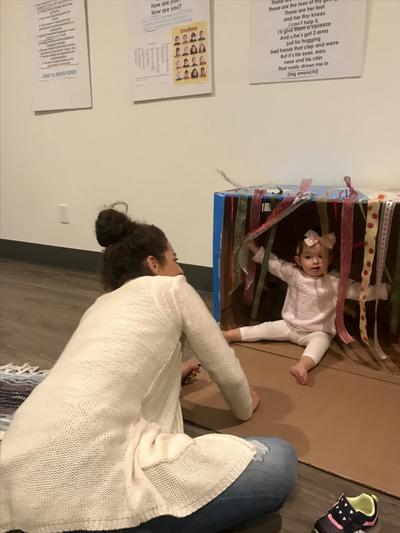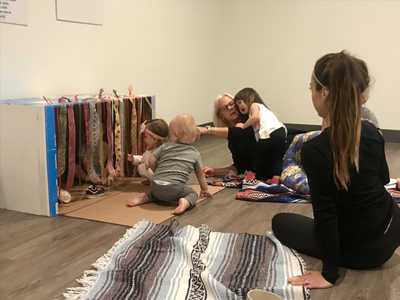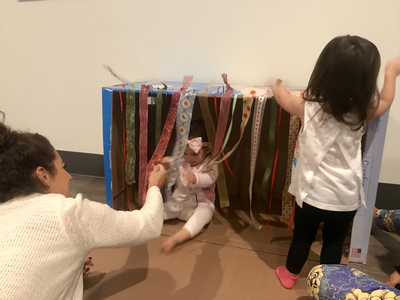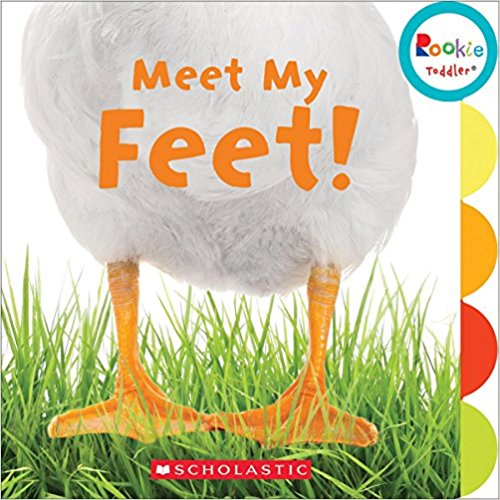Fun foundations class: feet
So what's up with body parts:
- Around 13 to 14 months, your toddler will really start learning body parts, and get a kick out of being able to point to that tiny nose when you ask.
- Facial features are easiest to start with - he’s always putting his paws on your face (in case you haven’t noticed), and you probably already name body parts as your child touches them (saying “mouth” whenever those chubby fingers graze your lips).
- Explain what each body part does too as he’s feeling your face: “Eyes help us see” or “Ears help us hear.” This will help reinforce the differences between body parts and make them easier for your toddler to tell apart.
- Milestones related to body parts:
- 9-12 mos, MAY be able to ID 2 body parts (but don't freak out if not)
- At 12-15 mos, can ID 3 body parts on self or doll
- By 15-18 mos, can ID 6 body parts or clothing items on self or doll
- By 2 years, can ID around 10 body parts + starts to name them
- Ways to practice body parts
- Songs! Obviously! ;) See below for a few.
- Ask for you to show you his eyes (or other body part), then your eyes, then on a doll/pet
- Trace your feet/hands on a piece of paper, then ID body parts — like the thumb or pinky toe — together. You can also draw the outline of a face and fill in the features as you name them. I particularly love using our Fisher Price "Doodle Pro" Board for this.
- Point to the reflection of your child's body parts in a mirror, as well as to characters’ body parts in books, as you name each one. Giving your toddler a variety of ways to practice identifying body parts will make learning their names more fun for you both.
- As they get older
- Ask him which body part helps him run, and wait for him to show you his legs or feet. Then ask which one helps him talk, and pause for him to point out his mouth. If he needs a hint, point to the part and let him name it.
- Any game that lets toddlers burn energy is a good thing. So try some Simon Says with body-based directions ("Simon says, wiggle your fingers"), or do the hokey-pokey but keep it simple (say “Put your hand in” and save left and right for later).
skills + strategies discussed in class
Translation: You guessed it - another indirect language facilitation strategy to add to your language-boosting toolbox! The reason I keep teaching you these is because THEY WORK! :)
Often times, particularly with toddlers, we get a little hung up on what a child is VERBALLY saying (or not saying) that we forget to look at how children are communicating with us in other ways. It is important for YOU, as a parent, to learn to watch your child for those times when he is communicating to you in other ways. Often times we are so busy watching for signs of speech, that we miss the many times our children are communicating to us - and what the message really is.
So here's how to interpret these communication messages so that we can eventually use them to help our children communicate more effectively!
Being a Translator: What it Means
We all know a translator or interpreter is someone who interprets or translates someone's messages to others. If we want to have a conversation with someone who doesn’t speak our native tongue, we need someone to translate our message to our communication partner. Now, it is time for you to start translating your child’s messages so that you can respond appropriately.
We have to listen with both our ears and OUR EYES to become awesome at translating. You are going to translate your child's message, based on your observations of your child’s ACTIONS, SOUNDS and VERBALIZATIONS. In other words: You are going to make an educated guess on what you think he is trying to communicate - and then verbally say what s/he WOULD say using a 1-4 word phrase, in first person language.
Being a Communication Detective: How to Interpret Your Child’s Message
Interpreting your child’s message takes a little bit of detective work sometimes. You have to watch and listen and sometimes use educated guesses to figure out what kind of message your child might be sending you. Here are the basic steps of interpreting your child:
What Does This Look Like?
Believe it or not, you’ve been interpreting your child’s messages from the day he was born, although you may not have always said them aloud to him. When he cried, you interpreted that to mean he needed to to eat, or needed a diaper change. When he smiled and laughed when you bounced him, you interpreted that to mean he liked the activity and wanted more.
Now that we are helping our children speak, we do the same exact thing, except we say out loud what our child might say in that moment. We want to use a 1-4 word phrase and use first person language (e.g. "I want.." not "you want..."). I've found it often helps for parents to preface this by saying, "You could say: ___________."
Here are some examples:
WHY practice Translation?
We want to model the phrases our child could be using to communicate their wants, needs and ideas.
We want to use first person language (I, me, my) to help them hear how those pronouns work in action.
Often times, particularly with toddlers, we get a little hung up on what a child is VERBALLY saying (or not saying) that we forget to look at how children are communicating with us in other ways. It is important for YOU, as a parent, to learn to watch your child for those times when he is communicating to you in other ways. Often times we are so busy watching for signs of speech, that we miss the many times our children are communicating to us - and what the message really is.
So here's how to interpret these communication messages so that we can eventually use them to help our children communicate more effectively!
Being a Translator: What it Means
We all know a translator or interpreter is someone who interprets or translates someone's messages to others. If we want to have a conversation with someone who doesn’t speak our native tongue, we need someone to translate our message to our communication partner. Now, it is time for you to start translating your child’s messages so that you can respond appropriately.
We have to listen with both our ears and OUR EYES to become awesome at translating. You are going to translate your child's message, based on your observations of your child’s ACTIONS, SOUNDS and VERBALIZATIONS. In other words: You are going to make an educated guess on what you think he is trying to communicate - and then verbally say what s/he WOULD say using a 1-4 word phrase, in first person language.
Being a Communication Detective: How to Interpret Your Child’s Message
Interpreting your child’s message takes a little bit of detective work sometimes. You have to watch and listen and sometimes use educated guesses to figure out what kind of message your child might be sending you. Here are the basic steps of interpreting your child:
- Sit back and quietly observe your child, listening with your eyes and your ears.
- Take note of what he is DOING. Is he….spending a long time playing with something? Smiling? Reaching out? Looking at you? Looking at something else? Turning away from something? Gesturing towards something? Pointing? What might these actions MEAN?
- Take note of what SOUNDS he is MAKING. Is he squealing? Laughing? Babbling? Do you hear infections in his babbling? What might these sounds MEAN?
- Take note of what WORDS (if any) he SAYING?
- Now, put all this together and use your detective skills and see if you can figure out what message he might be trying to send.
What Does This Look Like?
Believe it or not, you’ve been interpreting your child’s messages from the day he was born, although you may not have always said them aloud to him. When he cried, you interpreted that to mean he needed to to eat, or needed a diaper change. When he smiled and laughed when you bounced him, you interpreted that to mean he liked the activity and wanted more.
Now that we are helping our children speak, we do the same exact thing, except we say out loud what our child might say in that moment. We want to use a 1-4 word phrase and use first person language (e.g. "I want.." not "you want..."). I've found it often helps for parents to preface this by saying, "You could say: ___________."
Here are some examples:
- Scenario 1: Your toddler is playing with some toy cars. He reaches out towards a car near you, then looks at you, and then back at the car.
- Possible interpretation: It looks like your child wants the car.
- The caregiver could say in this scenario: “It looks like you want the car. You could say, 'Mom, I want car!'” then hand him the car.
- The caregiver could also simply say: "I want car!'” then hand him the car.
- Possible interpretation: It looks like your child wants the car.
- Scenario 2: You offer your child a banana and he pushes it away with his hand and turns his head away from you while squealing “ooooo”
- Possible interpretation:
- “No thank you! All done with banana.”
- Possible interpretation:
- Scenario 3: You are pushing your child in the swing and ask him “Do you want more swing?” He smiles and kicks his feet.
- Possible interpretation: “YES! I want more swing!” (If you had been ONLY focusing on his words, you may have missed him COMMUNICATING with his facial expression and foot movements!)
- Scenario 4: Your toddler is playing with playdoh and has been trying to flatten the dough with his hands. He looks around and says “Blue?”
- Possible interpretation: His questioning inflection makes you think he is asking something. Your first thought may be that he is asking for blue playdoh. But remember how he was trying to flatten the dough? Maybe he was actually asking for the roller, which is blue. This is why is is so important to listen with your eyes and not just your ears, because oftentimes, especially when there is little speech, a child’s nonverbal language is telling us so much more!
WHY practice Translation?
We want to model the phrases our child could be using to communicate their wants, needs and ideas.
We want to use first person language (I, me, my) to help them hear how those pronouns work in action.
Songs from FEEt class
|
|
LYRICS FOR "PUT YOUR FINGER ON YOUR FOOT"
(Tune: If You’re Happy and You Know It) Put your finger on your foot, on your foot. Put your finger on your foot, on your foot. Put your finger on your foot, Put your finger on your foot, Put your finger on your foot, on your foot. Next verses: substitute any body part! To increase difficulty, switch up the person or body parts throughout the song. For example: Put your finger on MY foot, on MY foot. Put your finger on DAD's foot, on DAD'S foot. Put your finger on CAT's foot, etc. |
|
|
LYRICS FOR "THESE ARE THE TOES OF MY BABY"
(Tune: Take Me Out to the Ball Game) These are the toes of my baby, These are the toes of my guy/gal! These are her feet and her tiny knees - I can’t help it, I’ll give them a squeeze! And s/he’s got 2 arms just for hugging, And hands that clap and wave! But his eyes, ears, nose and his chin Really draw me in (big smooch!) |
|
|
LYRICS FOR "EVERYBODY KNOWS I LOVE MY TOES"
1. Everybody knows I love my toes! Everybody knows I love my toes! I love my shoulders, my knees, my elbows, and my nose, But everybody knows I love my toes! 2. Everybody knows I love my eyes! Everybody knows I love my eyes! I love my shoulders, my knees, my elbows, and my thighs, But everybody knows I love my eyes! 3. I love my chin… ….my elbows and my shins… 4. I love my lips… ….my elbows and my hips… 5. I love my feet… ….my elbows and my seat… |
|
|
LYRICS FOR "WAKE UP FEET"
Wake up feet, wake up feet, Wake up feet and wiggle, wiggle, wiggle! Wake up feet, wake up feet, Wake up and wiggle in the morning! Could also try: • fingers • toes • nose |
|
|
LYRICS FOR "WAVE ONE FOOT"
(tune of 10 Little Indians) Wave one foot, And then the other. Wave one foot, And then the other. Wave one foot, And then the other. Wave with both feet now! Could also wave your: • hand • knee • elbow |
BOokS FOR TALKING ABOUT FEET!
|
The book we read in class was Meet My Feet by Rookie Toddler. This book is a fun book for talking about body parts and keeping kids interested by also talking about animals! You could tie in animal sounds, talking about where the animals live, etc. There is also a little red shoe hiding on all the pages - I didn't even realize that the first 3 times I read it! Ha.
On a sidenote, the Rookie Toddler series has some nice board books with basic language concepts appropriate for toddlers. |
|
I also LOVE the Foot Book by Dr. Seuss! It's a must have for every child's library. It talks about feet A LOT (obviously haha), but also nicely ties in a lot of opposite concepts. This is a book that toddlers could grow into and read for many years to come (unlike the book we read in class).
|
















